Search Result
Results for "
Lenalidomide
" in MedChemExpress (MCE) Product Catalog:
1
Isotope-Labeled Compounds
| Cat. No. |
Product Name |
Target |
Research Areas |
Chemical Structure |
-
- HY-A0003
-
Lenalidomide
Maximum Cited Publications
32 Publications Verification
CC-5013
|
Ligands for E3 Ligase
Molecular Glues
Apoptosis
|
Inflammation/Immunology
Cancer
|
|
Lenalidomide (CC-5013), a derivative of Thalidomide, acts as molecular glue. Lenalidomide is an orally active immunomodulator. Lenalidomide (CC-5013) is a ligand of ubiquitin E3 ligase cereblon (CRBN), and it causes selective ubiquitination and degradation of two lymphoid transcription factors, IKZF1 and IKZF3, by the CRBN-CRL4 ubiquitin ligase. Lenalidomide (CC-5013) specifically inhibits growth of mature B-cell lymphomas, including multiple myeloma, and induces IL-2 release from T cells .
|
-
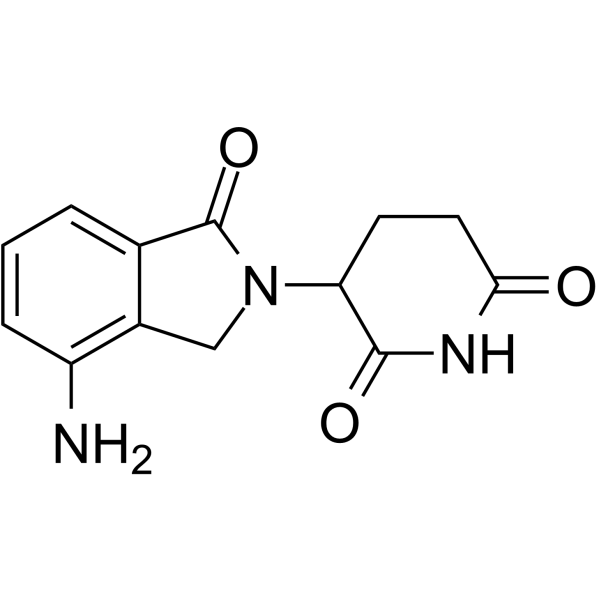
-
- HY-160241
-
-
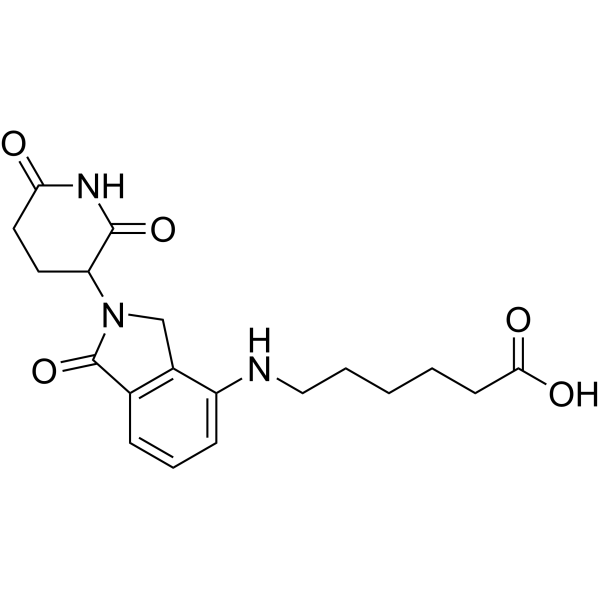
-
- HY-161133
-
|
|
E3 Ligase Ligand-Linker Conjugates
|
Cancer
|
|
Lenalidomide 4'-PEG1-azide (Compound 4g) is a lenalidomide-derived azide. Lenalidomide 4'-PEG1-azide incorporates the Lenalidomide based cereblon ligand and a linker. Lenalidomide 4'-PEG1-azide is a click chemistry reagent, it contains an Azide group and can undergo copper-catalyzed azide-alkyne cycloaddition reaction (CuAAc) with molecules containing Alkyne groups. Strain-promoted alkyne-azide cycloaddition (SPAAC) can also occur with molecules containing DBCO or BCN groups. .
|
-
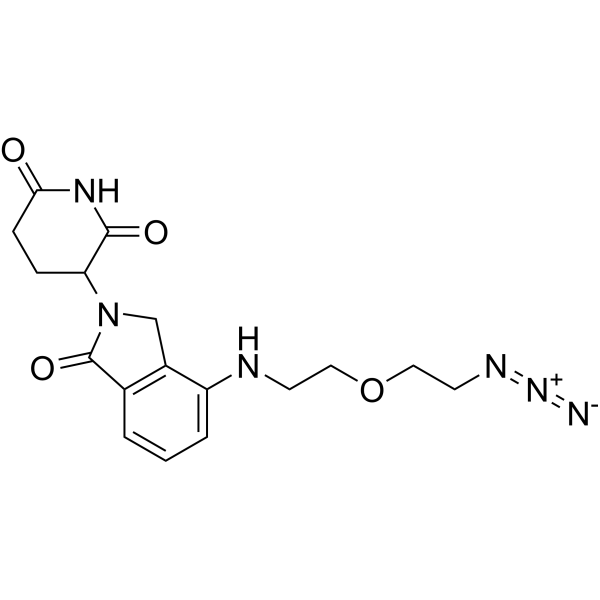
-
- HY-161129
-
|
|
Ligands for E3 Ligase
|
Cancer
|
|
Lenalidomide 4'-PEG2-amine dihydrochloride is the Lenalidomide-based Cereblon ligand used in the recruitment of CRBN protein. Lenalidomide 4'-PEG2-amine dihydrochloride can be connected to the ligand for protein by a linker to form PROTAC .
|
-
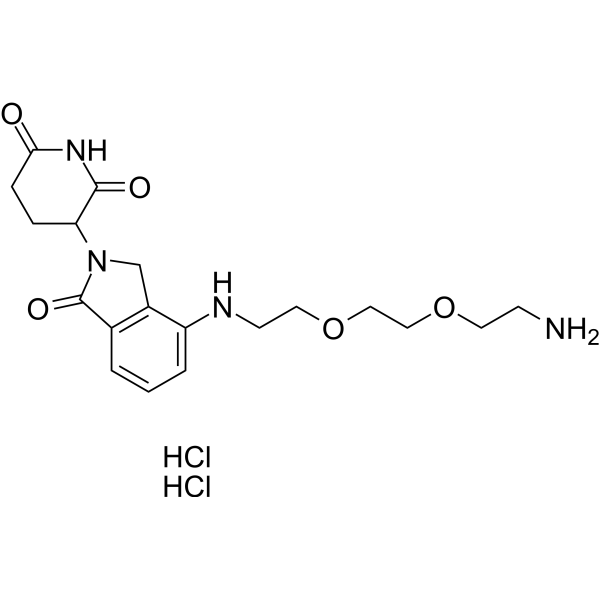
-
- HY-161128
-
|
|
Ligands for E3 Ligase
|
Cancer
|
|
Lenalidomide 4'-PEG1-amine dihydrochloride is the Lenalidomide-based Cereblon ligand used in the recruitment of CRBN protein. Lenalidomide 4'-PEG1-amine dihydrochloride can be connected to the ligand for protein by a linker to form PROTAC .
|
-
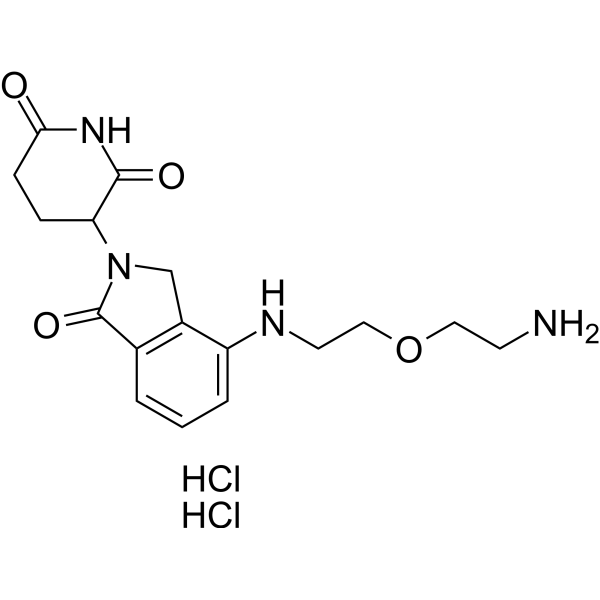
-
- HY-161130
-
|
|
Ligands for E3 Ligase
|
Cancer
|
|
Lenalidomide 4'-PEG3-amine dihydrochloride is the Lenalidomide-based Cereblon ligand used in the recruitment of CRBN protein. Lenalidomide 4'-PEG3-amine dihydrochloride can be connected to the ligand for protein by a linker to form PROTAC .
|
-
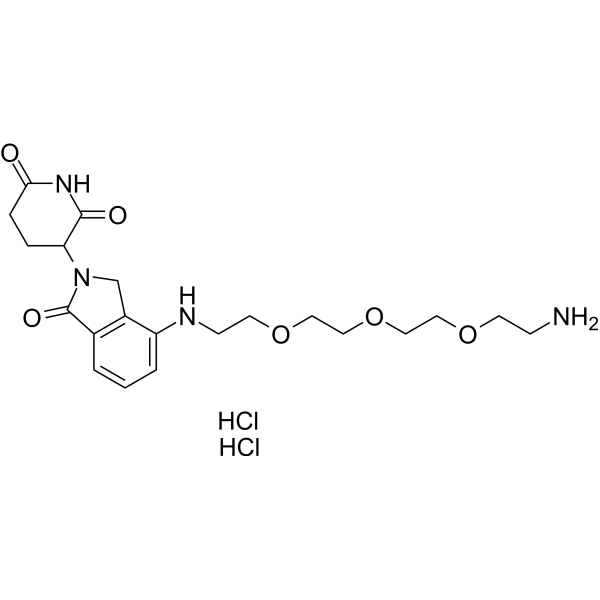
-
- HY-161134
-
|
|
Ligands for E3 Ligase
|
Cancer
|
|
Lenalidomide 4'-PEG2-azide is the Lenalidomide-based Cereblon ligand used in the recruitment of CRBN protein. Lenalidomide 4'-PEG2-azide can be connected to the ligand for protein by a linker to form PROTAC .
|
-

-
- HY-122725A
-
|
|
E3 Ligase Ligand-Linker Conjugates
|
Cancer
|
|
Lenalidomide-C5-NH2 is the Lenalidomide-based Cereblon ligand used in the recruitment of CRBN protein. Lenalidomide-C5-NH2 can be connected to the ligand for protein by a linker to form PROTACs, such as MDM2 PROTAC degrader .
|
-
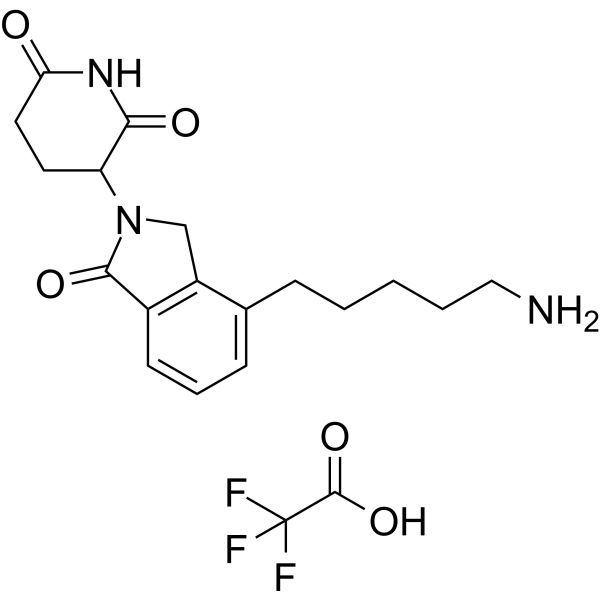
-
- HY-130982
-
|
|
E3 Ligase Ligand-Linker Conjugates
|
Cancer
|
|
Lenalidomide-PEG3-iodine is a synthesized E3 ligase ligand-linker conjugate that incorporates the Lenalidomide based cereblon ligand and a 3-unit PEG linker. Lenalidomide-PEG3-iodine can be used in the synthesis of a series of PROTACs, such as SJF620 (HY-133137). SJF620 is a potent PROTAC BTK degrader with a DC50 of 7.9 nM .
|
-

-
- HY-W076696
-
|
|
Ligands for E3 Ligase
|
Cancer
|
|
Lenalidomide-4-OH is the Lenalidomide-based cereblon (CRBN) ligand used in the recruitment of CRBN protein. Lenalidomide-4-OH can be connected to the ligand for protein by a linker to form PROTAC.
|
-
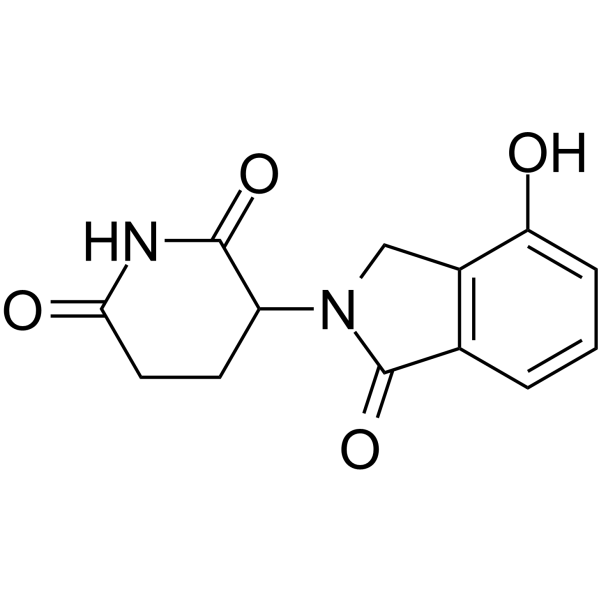
-
- HY-W072954
-
|
|
Ligands for E3 Ligase
|
Cancer
|
|
Lenalidomide-5-Br is the Lenalidomide-based cereblon (CRBN) ligand used in the recruitment of CRBN protein. Lenalidomide-5-Br can be connected to the ligand for protein by a linker to form PROTAC .
|
-
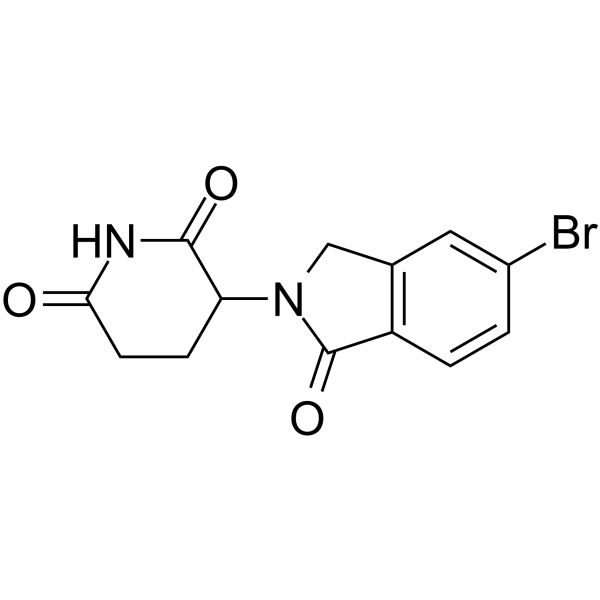
-
- HY-W077589A
-
|
|
Ligands for E3 Ligase
|
Cancer
|
|
Lenalidomide-5-aminomethyl is the Lenalidomide-based cereblon (CRBN) ligand used in the recruitment of CRBN protein. Lenalidomide-5-aminomethyl can be connected to the ligand for protein by a linker to form PROTAC .
|
-
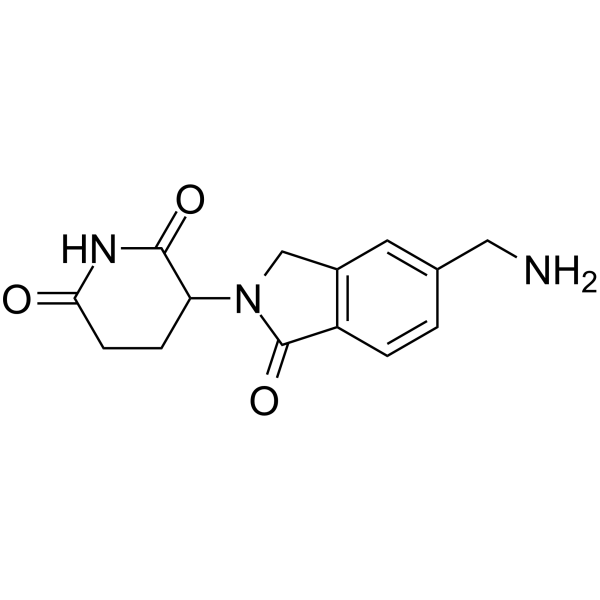
-
- HY-W077589
-
|
|
Ligands for E3 Ligase
|
Cancer
|
|
Lenalidomide-5-aminomethyl hydrochloride is the Lenalidomide-based cereblon (CRBN) ligand used in the recruitment of CRBN protein. Lenalidomide-5-aminomethyl hydrochloride can be connected to the ligand for protein by a linker to form PROTAC
|
-
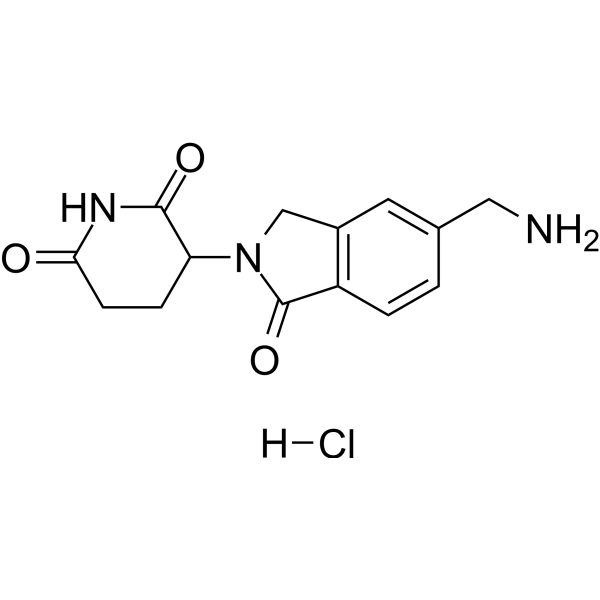
-
- HY-138881
-
|
|
Ligands for E3 Ligase
|
Cancer
|
|
Lenalidomide-6-F is the Lenalidomide-based cereblon (CRBN) ligand used in the recruitment of CRBN protein. Lenalidomide-6-F can be connected to the ligand for protein by a linker to form PROTAC .
|
-
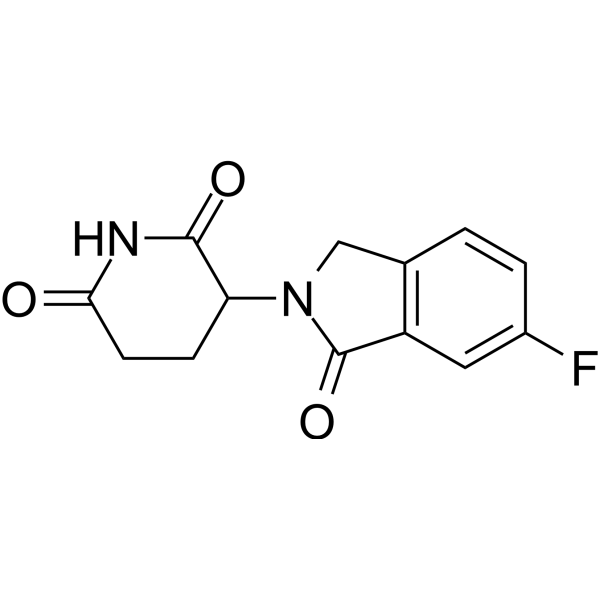
-
- HY-138882A
-
|
|
Ligands for E3 Ligase
|
Cancer
|
|
Lenalidomide-4-aminomethyl hydrochloride is the Lenalidomide-based cereblon (CRBN) ligand used in the recruitment of CRBN protein. Lenalidomide-4-aminomethyl hydrochloride can be connected to the ligand for protein by a linker to form PROTAC
|
-
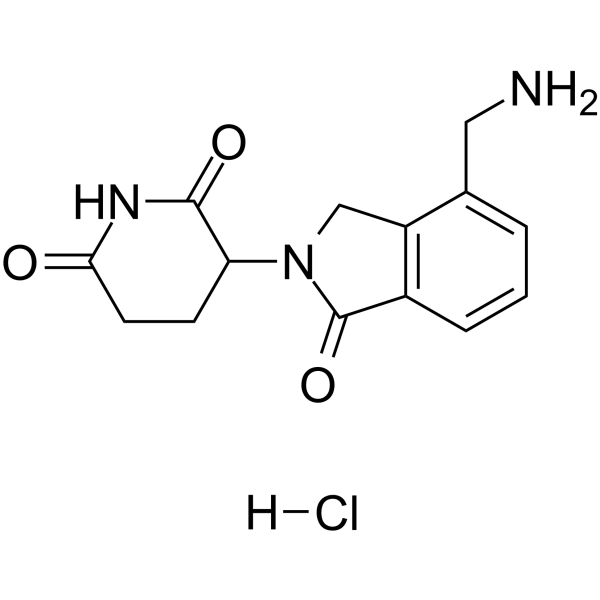
-
- HY-138882
-
|
|
Ligands for E3 Ligase
|
Cancer
|
|
Lenalidomide-4-aminomethyl is the Lenalidomide-based cereblon (CRBN) ligand used in the recruitment of CRBN protein. Lenalidomide-4-aminomethyl can be connected to the ligand for protein by a linker to form PROTAC .
|
-
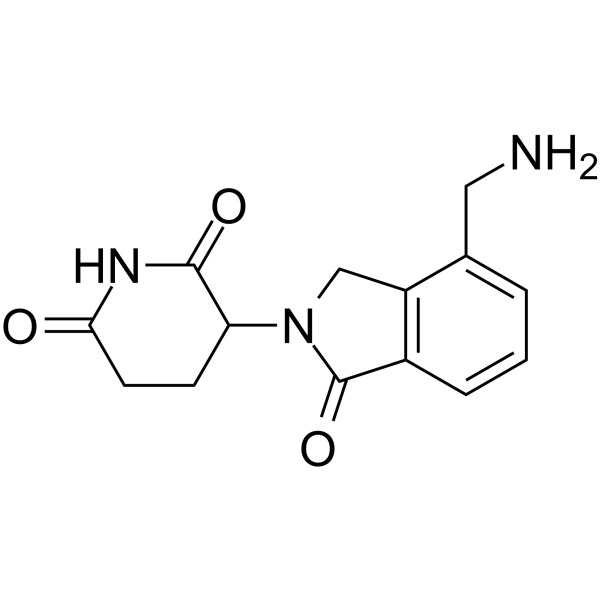
-
- HY-132248
-
|
Lenalidomide 5'-amine
|
TNF Receptor
|
Inflammation/Immunology
|
|
C5 Lenalidomide (Lenalidomide 5'-amine) is a thalidomide analog and is a potent inhibitor of TNF-alpha production (IC50=100 μM in LPS stimulated human PBMC) .
|
-
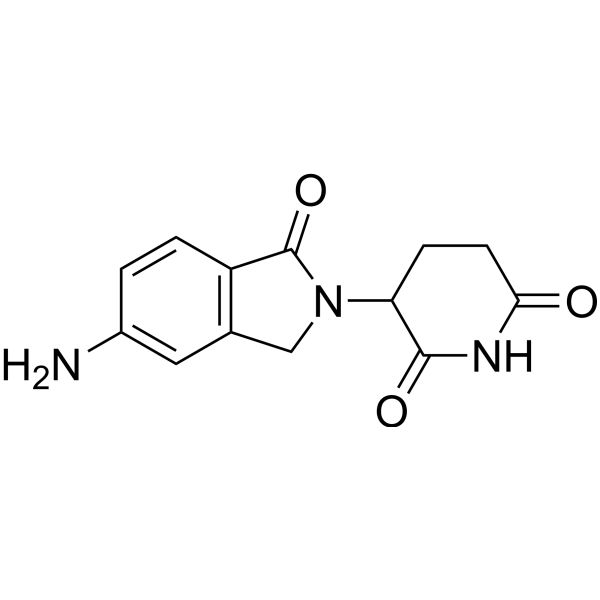
-
- HY-133144
-
|
|
Ligands for E3 Ligase
|
Cancer
|
|
Lenalidomide-OH is an analog of cereblon (CRBN) ligand Lenalidomide for E3 ubiquitin ligase, and is used in the recruitment of CRBN protein. Lenalidomide-OH can be connected to the ligand for protein by a linker to form PROTACs, such as the PROTAC BTK degrader SJF620 (HY-133137) .
|
-
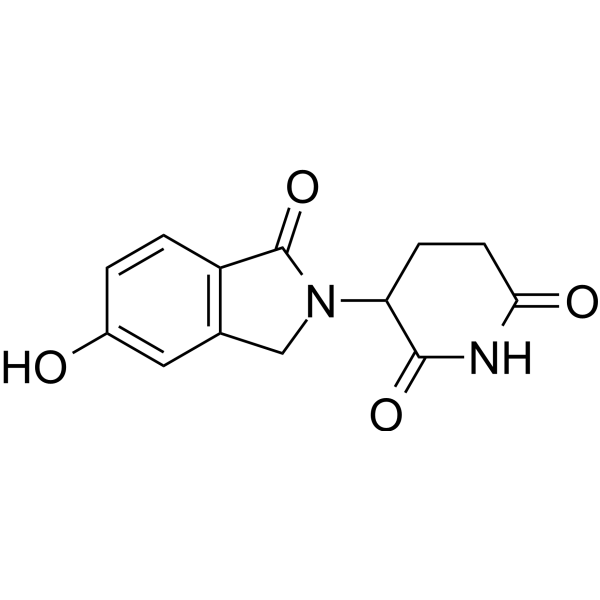
-
- HY-131318
-
|
|
Ligands for E3 Ligase
|
Cancer
|
|
Lenalidomide-I (Compound 72), an analog of cereblon (CRBN) ligand Lenalidomide for E3 ubiquitin ligase, is used in the recruitment of CRBN protein. Lenalidomide-I can be connected to the ligand for protein by a linker to form PROTACs, such as the PROTAC BET degrader QCA570 (HY-112609) .
|
-

-
- HY-43722
-
|
|
Ligands for E3 Ligase
|
Cancer
|
|
Lenalidomide-Br (Compound 41) is an analog of cereblon (CRBN) ligand Lenalidomide for E3 ubiquitin ligase, and is used in the recruitment of CRBN protein. Lenalidomide-Br can be connected to the ligand for protein by a linker to form PROTACs, such as the PROTAC STAT3 degrader SD-36 (HY-129602) .
|
-
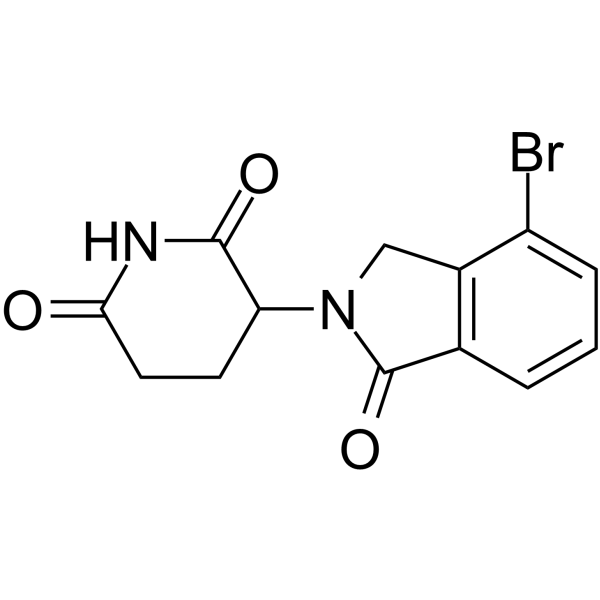
-
- HY-A0003B
-
|
CC-5013 hemihydrate
|
Ligands for E3 Ligase
Molecular Glues
Apoptosis
|
Cancer
|
|
Lenalidomide hemihydrate (CC-5013 hemihydrate), a derivative of Thalidomide, acts as molecular glue. Lenalidomide hemihydrate is an orally active immunomodulator. Lenalidomide hemihydrate (CC-5013 hemihydrate) is a ligand of ubiquitin E3 ligase cereblon (CRBN), and it causes selective ubiquitination and degradation of two lymphoid transcription factors, IKZF1 and IKZF3, by the CRBN-CRL4 ubiquitin ligase. Lenalidomide hemihydrate (CC-5013 hemihydrate) specifically inhibits growth of mature B-cell lymphomas, including multiple myeloma, and induces IL-2 release from T cells .
|
-
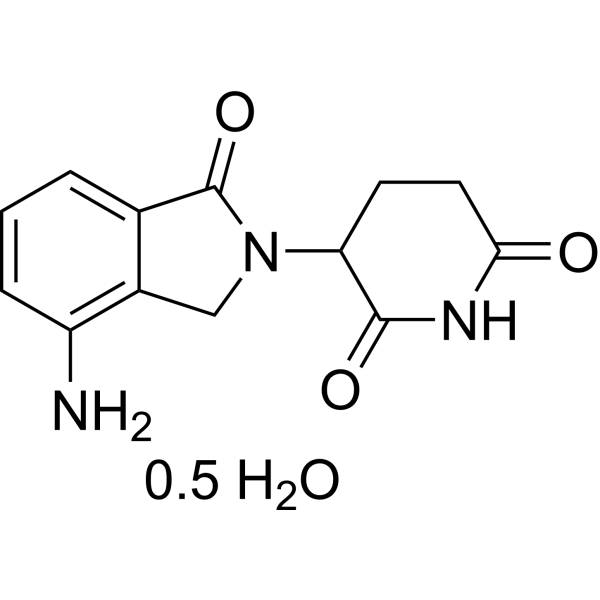
-
- HY-A0003A
-
|
CC-5013 hydrochloride
|
Ligands for E3 Ligase
Molecular Glues
|
Inflammation/Immunology
Cancer
|
|
Lenalidomide hydrochloride (CC-5013 hydrochloride), a derivative of Thalidomide, acts as molecular glue. Lenalidomide hydrochloride is an orally active immunomodulator. Lenalidomide hydrochloride (CC-5013 hydrochloride) is a ligand of ubiquitin E3 ligase cereblon (CRBN), and it causes selective ubiquitination and degradation of two lymphoid transcription factors, IKZF1 and IKZF3, by the CRBN-CRL4 ubiquitin ligase. Lenalidomide hydrochloride (CC-5013 hydrochloride) specifically inhibits growth of mature B-cell lymphomas, including multiple myeloma, and induces IL-2 release from T cells .
|
-
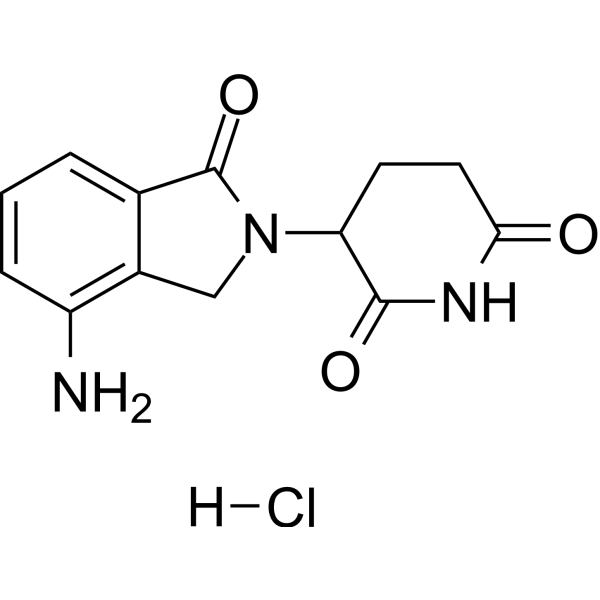
-
- HY-132856
-
|
|
E3 Ligase Ligand-Linker Conjugates
|
Cancer
|
|
Lenalidomide-C5-amido-Boc is the Lenalidomide-based Cereblon ligand used in the recruitment of CRBN protein. Lenalidomide-C5-amido-Boc can be connected to the ligand for protein by a linker to form PROTAC .
|
-
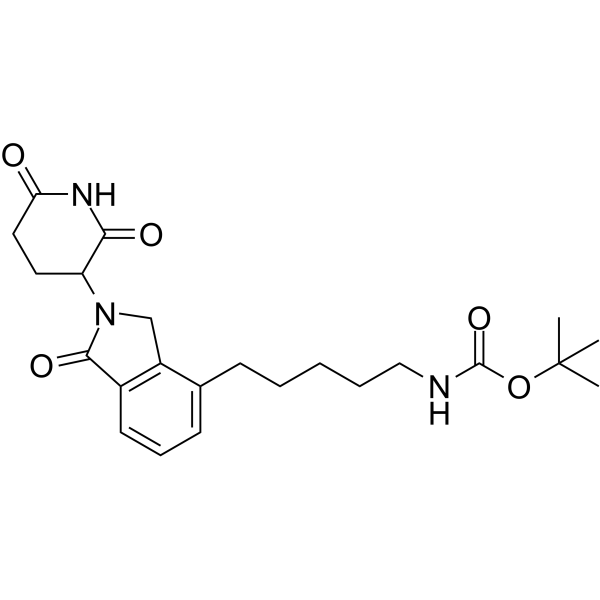
-
- HY-133139
-
|
|
E3 Ligase Ligand-Linker Conjugates
|
Cancer
|
|
Lenalidomide-PEG1-azide is a E3 ligase lgand-linker conjugate. Lenalidomide-PEG1-azide incorporates the Lenalidomide based cereblon ligand and a linker.?Lenalidomide-PEG1-azide?can be used to design a PROTAC BRD4 Degrader-2 (HY-133136) . Lenalidomide-PEG1-azide is a click chemistry reagent, it contains an Azide group and can undergo copper-catalyzed azide-alkyne cycloaddition reaction (CuAAc) with molecules containing Alkyne groups. Strain-promoted alkyne-azide cycloaddition (SPAAC) can also occur with molecules containing DBCO or BCN groups.
|
-
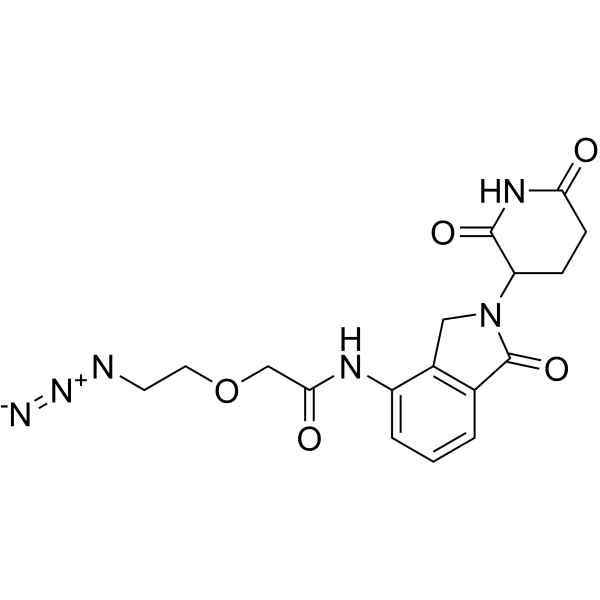
-
- HY-122725B
-
|
|
E3 Ligase Ligand-Linker Conjugates
|
Cancer
|
|
Lenalidomide-C5-NH2 hydrochloride is the Lenalidomide-based Cereblon ligand used in the recruitment of CRBN protein. Lenalidomide-C5-NH2 can be connected to the ligand for protein by a linker to form PROTACs, such as MDM2 PROTAC degrader .
|
-
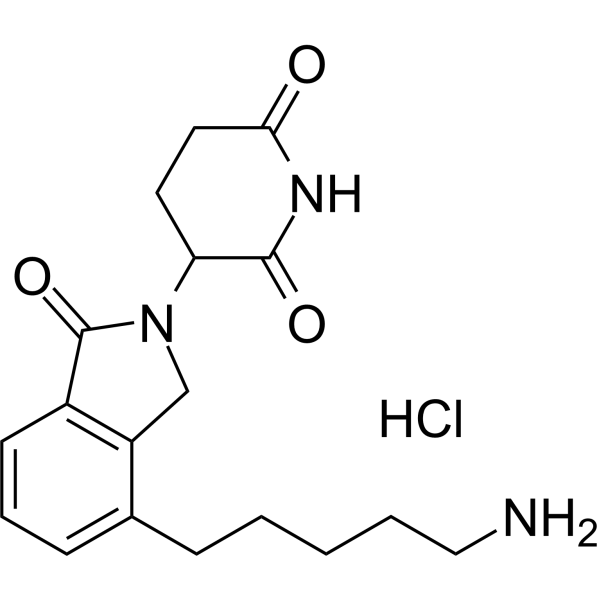
-
- HY-A0003S
-
|
CC-5013-d5
|
Isotope-Labeled Compounds
Ligands for E3 Ligase
Molecular Glues
Apoptosis
|
Inflammation/Immunology
Cancer
|
|
Lenalidomide-d5 is deuterium labeled Lenalidomide. Lenalidomide (CC-5013), a derivative of Thalidomide, acts as molecular glue. Lenalidomide is an orally active immunomodulator. Lenalidomide (CC-5013) is a ligand of ubiquitin E3 ligase cereblon (CRBN), and it causes selective ubiquitination and degradation of two lymphoid transcription factors, IKZF1 and IKZF3, by the CRBN-CRL4 ubiquitin ligase. Lenalidomide (CC-5013) specifically inhibits growth of mature B-cell lymphomas, including multiple myeloma, and induces IL-2 release from T cells[1][2].
|
-

-
- HY-139563
-
|
|
Others
|
Others
|
|
Lenalidomide-C10-OH (6a) is an intermediate in the synthesis of INY-03-041 .
|
-
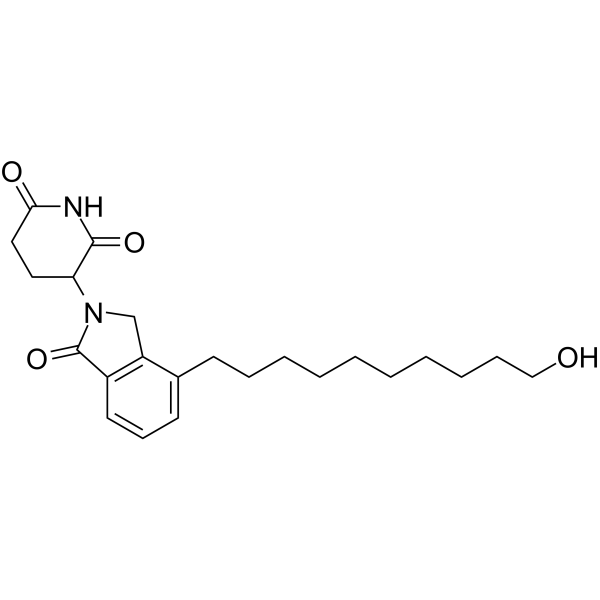
-
- HY-161131
-
|
|
Ligands for E3 Ligase
Apoptosis
Molecular Glues
|
Inflammation/Immunology
|
|
Lenalidomide 4'-alkyl-C3-azide (compound 4a) is a click chemical modified Lenalidomide (HY-A0003) that can be used to synthesize PROTACs. Lenalidomide is an orally active immunomodulator and a ligand for the ubiquitin E3 ligase cereblon (CRBN). Lenalidomide 4'-alkyl-C3-azide contains an Azide group and can undergo copper-catalyzed azide-alkyne cycloaddition reaction (CuAAc) with molecules containing Alkyne groups. Strain-promoted alkyne-azide cycloaddition reactions (SPAAC) can also occur with molecules containing DBCO or BCN groups .
|
-
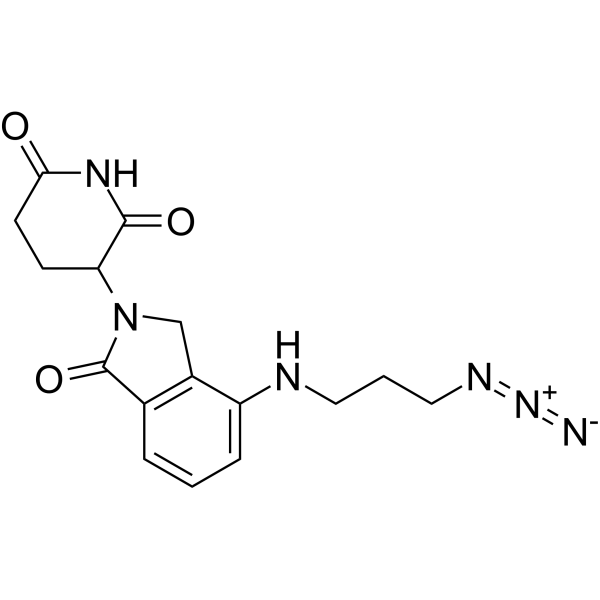
-
- HY-129608
-
|
Cereblon ligand-linker Conjugate
|
E3 Ligase Ligand-Linker Conjugates
|
Cancer
|
|
Lenalidomide-acetylene-C5-COOH (compound 43; Cereblon ligand-linker Conjugate) is the Lenalidomide-based Cereblon ligand used in the recruitment of CRBN protein. Lenalidomide-acetylene-C5-COOH can be connected to the ligand for protein by a linker to form PROTAC . Lenalidomide-acetylene-C5-COOH is a click chemistry reagent, it contains an Alkyne group and can undergo copper-catalyzed azide-alkyne cycloaddition (CuAAc) with molecules containing Azide groups.
|
-
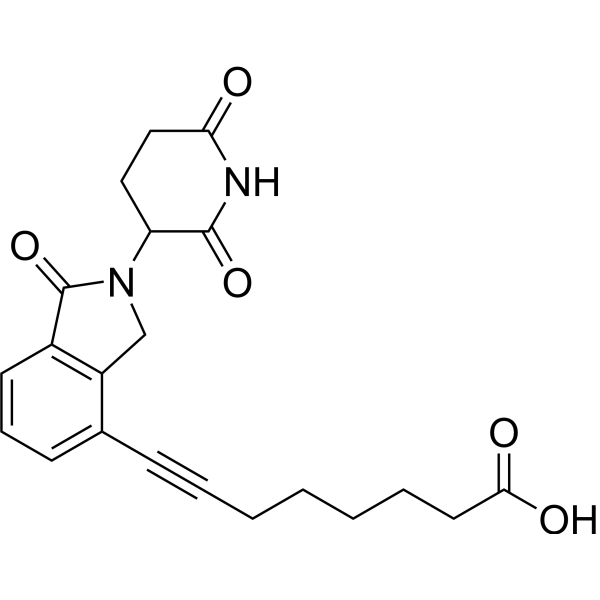
-
- HY-130683
-
|
|
E3 Ligase Ligand-Linker Conjugates
|
Cancer
|
|
Lenalidomide-propargyl-C2-NH2 hydrochloride incorporates a cereblon (CRBN) ligand for the E3 ubiquitin ligase, and a linker. Lenalidomide-propargyl-C2-NH2 hydrochloride can be used to design the PROTAC MD-224 (HY-114312) . Lenalidomide-propargyl-C2-NH2 (hydrochloride) is a click chemistry reagent, it contains an Alkyne group and can undergo copper-catalyzed azide-alkyne cycloaddition (CuAAc) with molecules containing Azide groups.
|
-
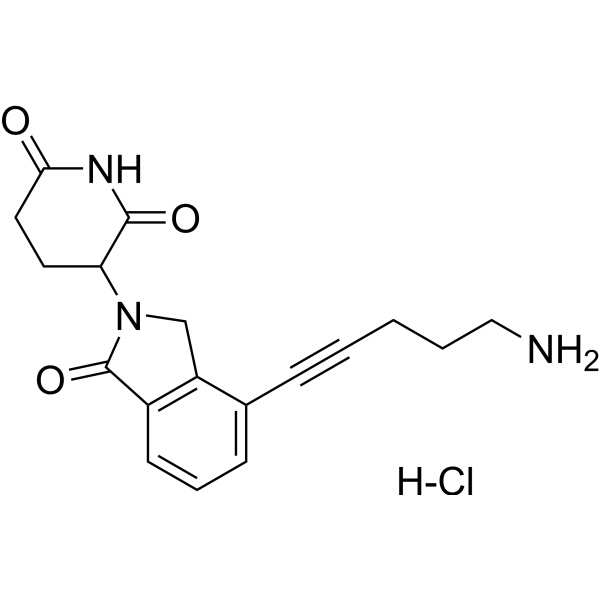
-
- HY-W259932
-
|
|
Ligands for E3 Ligase
|
Cancer
|
|
Lenalidomide 5'-piperazine is a functionalized cerebellar ligand for PROTAC development that binds an E3 ligand to terminal piperazine for subsequent chemical reactions to produce a protein deactivator with a rigid linker .
|
-

-
- HY-156700
-
|
|
PROTAC Linkers
|
Cancer
|
|
Lenalidomide-acetylene-Br is a PROTAC Linker taht makes up HJM-561 (HY-156698). HJM-561 is a potent, selective, and orally active EGFR PROTAC to inhiibit Osimertinib (HY-15772)-resistant EGFR triple mutations.
|
-
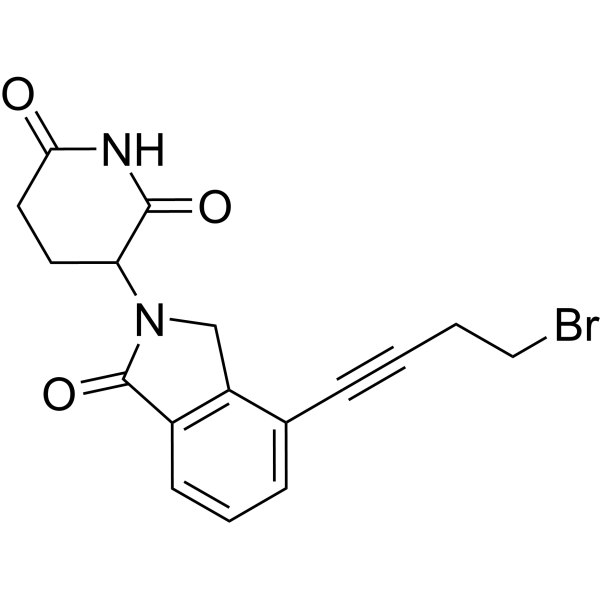
-
- HY-130682
-
|
|
E3 Ligase Ligand-Linker Conjugates
|
Cancer
|
|
Lenalidomide-propargyl-C2-amido-Ph-NH2 hydrochloride incorporates a cereblon (CRBN) ligand for the E3 ubiquitin ligase and a linker. Lenalidomide-propargyl-C2-amido-Ph-NH2 hydrochloride can be used to design the PROTAC MD-224 (HY-114312) . Lenalidomide-propargyl-C2-amido-Ph-NH2 (hydrochloride) is a click chemistry reagent, it contains an Alkyne group and can undergo copper-catalyzed azide-alkyne cycloaddition (CuAAc) with molecules containing Azide groups.
|
-
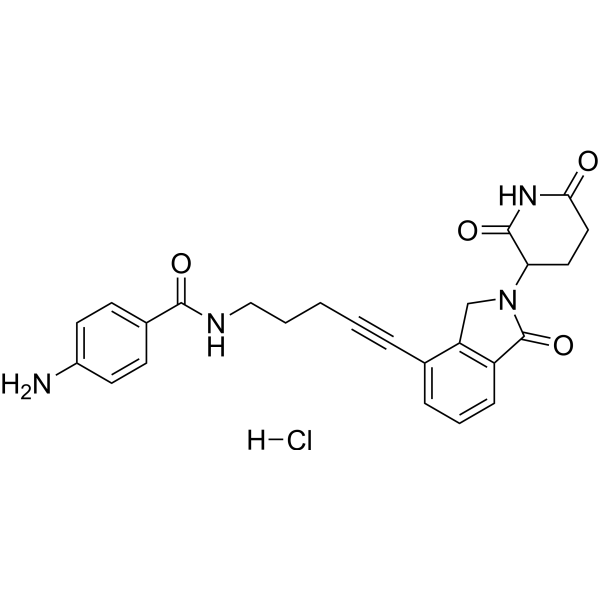
-
- HY-157566
-
|
|
Ligands for E3 Ligase
|
Cancer
|
|
Lenalidomide 5'-piperazine-4-methylpiperidine hydrochloride is a functionalized cerebellar ligand for PROTAC development, combining E3 ligand and terminal piperidine for subsequent chemical reactions. A protein degradant with a rigid connector is generated .
|
-
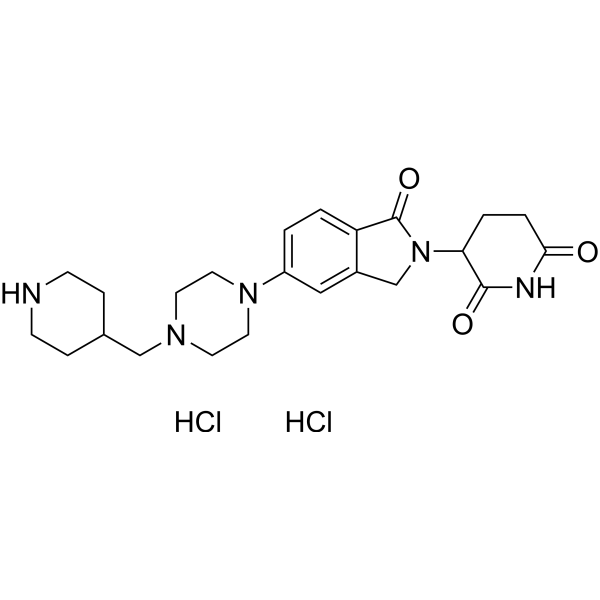
-
- HY-161132
-
|
|
Ligands for E3 Ligase
|
Others
|
|
Lenalidomide 4'-alkyl-C5-azide is a functionalized cerebellar ligand for PROTAC development that contains an E3 ligand and an alkyl LC5 ligand with terminal azides that can be coupled to a target protein ligand .
|
-

-
- HY-115446A
-
|
Cereblon ligand 1 hydrochloride; E3 ligase Ligand-Linker Conjugates 32 hydrochloride
|
E3 Ligase Ligand-Linker Conjugates
|
Cancer
|
|
Lenalidomide-C4-NH2 hydrochloride is the Lenalidomide-based Cereblon ligand used in the recruitment of CRBN protein. Lenalidomide-C4-NH2 hydrochloride can be connected to the ligand for protein by a linker to form PROTAC (Compound 24), which has IC50s of 0.98 nM and 13.7 nM in inhibition of RS4;11 and MOLM-13 acute leukemia cell lines growth, respectively .
|
-
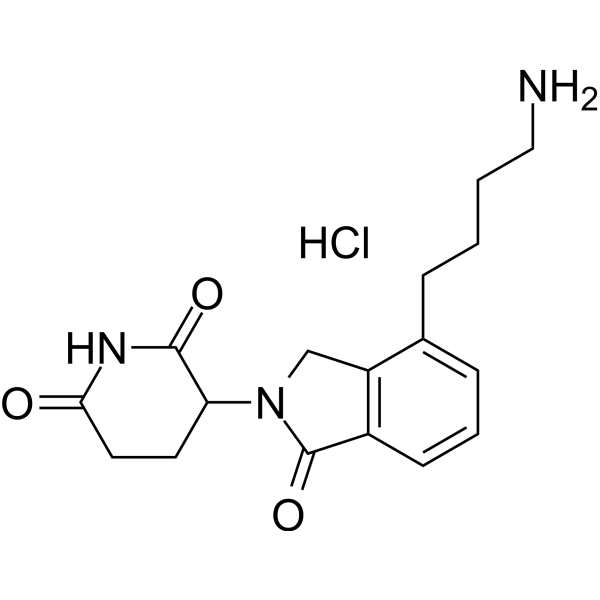
-
- HY-139340
-
|
|
Others
|
Others
|
|
Photo-lenalidomide-acid (compound 3) is a photacts consist of a ligand for an E3 ligase, a photoswitch, and a ligand for a protein of interest and enable optical control of protein degradation .
|
-

-
- HY-133137
-
|
|
PROTACs
Btk
|
Cancer
|
|
SJF620 is a PROTAC connected by ligands for Cereblon and Btk with a DC50 of 7.9 nM. SJF620 contains a Lenalidomide analog for recruiting CRBN .
|
-
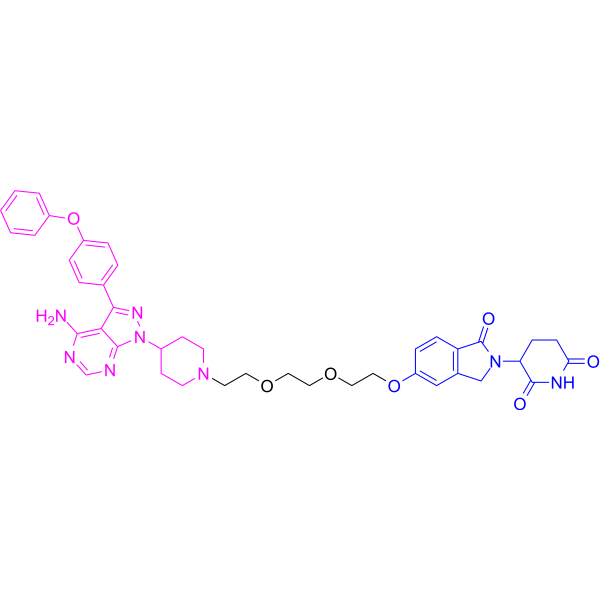
-
- HY-133137A
-
|
|
PROTACs
Btk
|
Cancer
|
|
SJF620 hydrochloride is a PROTAC connected by ligands for Cereblon and Btk with a DC50 of 7.9 nM. SJF620 contains a Lenalidomide analog for recruiting CRBN .
|
-
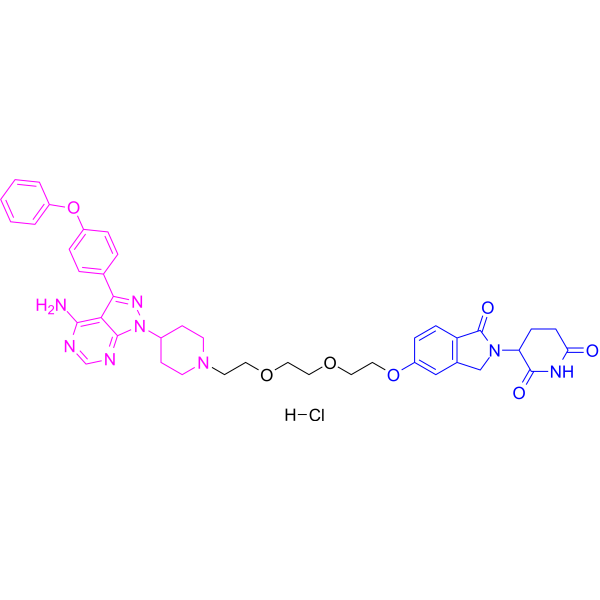
-
- HY-157767
-
|
|
PROTACs
ATM/ATR
|
Cancer
|
|
Abd110 (compound 42i) is a Lenalidomide-based PROTAC ATR kinase degrader. Abd110 selectively decreases ATR and phospho-ATR without affecting related kinases ATM and DNA-PKcs .
|
-

-
- HY-130988A
-
|
GDC-0068-NH2 dihydrochloride; RG7440-NH2 dihydrochloride
|
Ligands for Target Protein for PROTAC
|
Cancer
|
|
Ipatasertib-NH2 dihydrochloride is a ligand for target protein AKT for PROTAC (INY-03-041). INY-03-041 is composed of Ipatasertib-NH2, a ten-hydrocarbon linker, and a CRBN ligand Lenalidomide for E3 ubiquitin ligase .
|
-
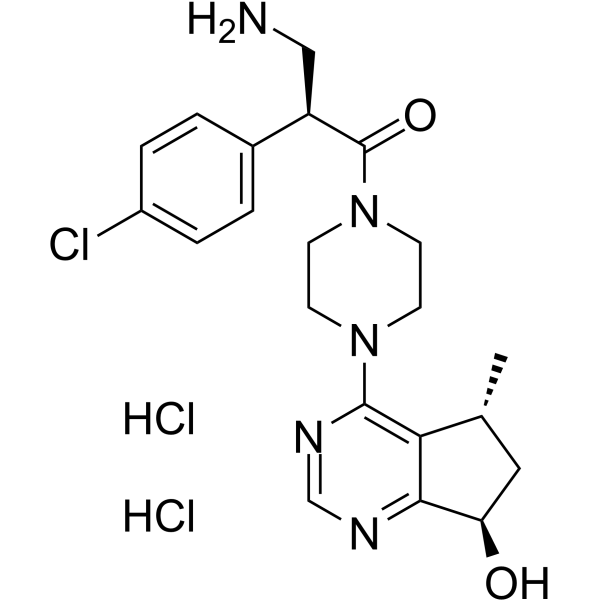
-
- HY-130988
-
|
GDC-0068-NH2; RG7440-NH2
|
Ligands for Target Protein for PROTAC
|
Cancer
|
|
Ipatasertib-NH2 (GDC-0068-NH2;RG7440-NH2) is a ligand for target protein AKT for PROTAC (INY-03-041). INY-03-041 is composed of Ipatasertib-NH2, a ten-hydrocarbon linker, and a CRBN ligand Lenalidomide for E3 ubiquitin ligase .
|
-
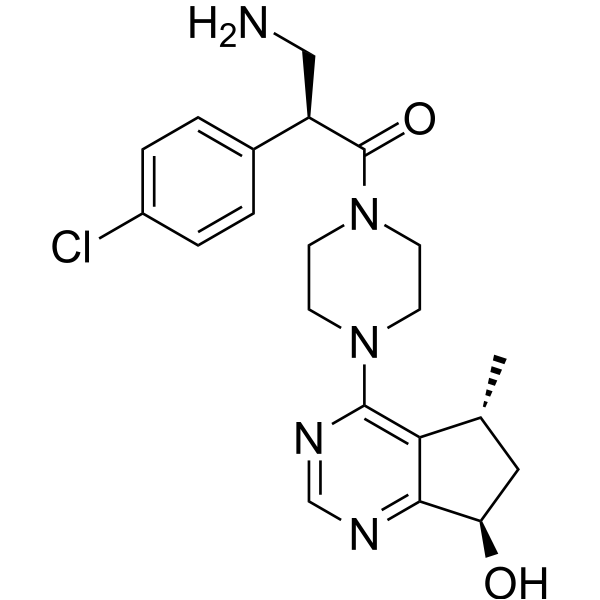
-
- HY-154984
-
|
|
Histone Acetyltransferase
PROTACs
|
Cancer
|
|
JET-209 is a potent PROTAC CBP/p300 degrader, with DC50 values of 0.05 nM and 0.2 nM for CBP and p300. JET-209 contains Lenalidomide (HY-A0003) (the cereblon ligand), a linker and GNE-207 (HY-120028) (bromodomain Inhibitor). JET-209 is used for cancer research .
|
-
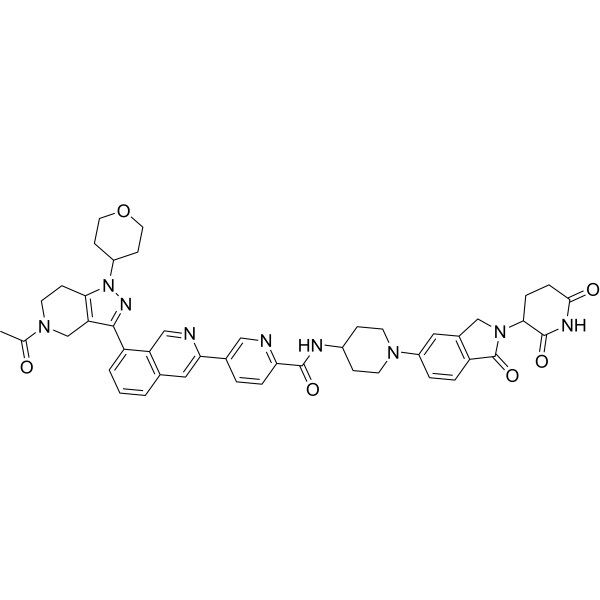
-
- HY-130985
-
|
|
PROTAC Linkers
|
Cancer
|
|
9-Decyn-1-ol is an alkyl/ether-based PROTAC linker that can be used in the synthesis of PROTACs. 9-Decyn-1-ol can be used to conjugate GDC-0068 with Lenalidomide to generate INY-03-041. INY-03-041 is a potent, highly selective and PROTAC-based pan-Akt degrader. INY-03-041 inhibits Akt1, Akt2 and Akt3 with IC50s of 2.0 nM, 6.8 nM and 3.5 nM, respectively . 9-Decyn-1-ol is a click chemistry reagent, it contains an Alkyne group and can undergo copper-catalyzed azide-alkyne cycloaddition (CuAAc) with molecules containing Azide groups.
|
-
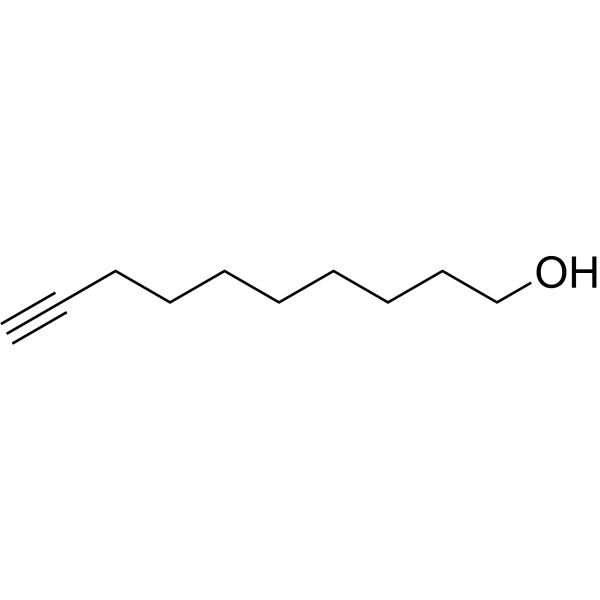
-
- HY-133120
-
|
|
PROTACs
Akt
|
Cancer
|
|
INY-03-041 is a potent, highly selective and PROTAC-based pan-AKT degrader consisting of the ATP-competitive AKT inhibitor Ipatasertib (HY-15186) conjugated to Lenalidomide (HY-A0003, Cereblon ligand). INY-03-041 inhibits AKT1, AKT2 and AKT3 with IC50s of 2.0, 6.8 and 3.5 nM, respectively .
|
-
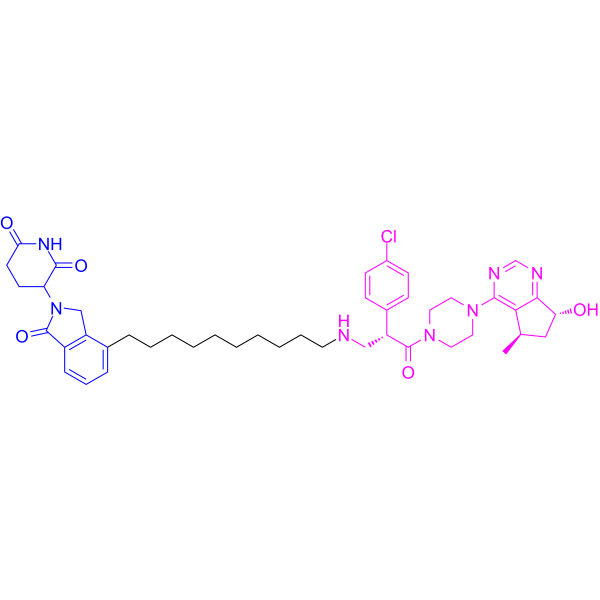
-
- HY-134823
-
|
|
MDM-2/p53
PROTACs
E1/E2/E3 Enzyme
|
Cancer
|
|
MD-222 is the first-in-class highly potent PROTAC degrader of MDM2. MD-222 consists of ligands for Cereblon and MDM2. MD-222 induces rapid degradation of the MDM2 protein and activation of wild-type p53 in cells. MD-222 has anticancer effects .
|
-
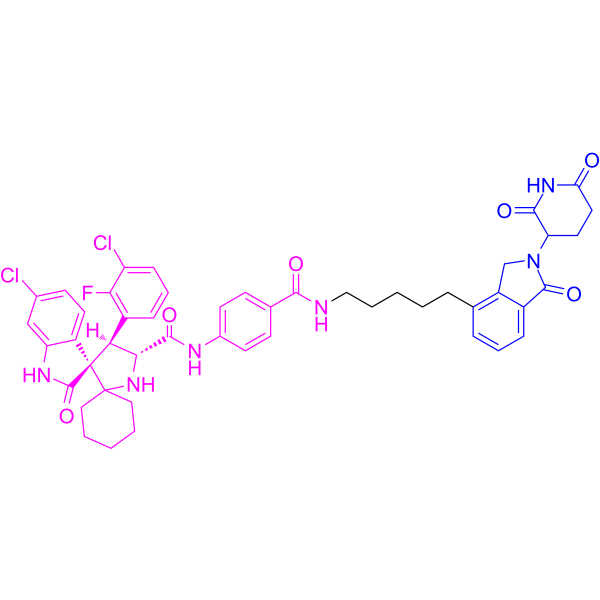
-
- HY-120084
-
|
|
Casein Kinase
|
Cancer
|
|
BTX161, a Thalidomide analog, is a potent CKIα degrader. BTX161 mediates degradation of CKIα better than Lenalidomide in human AML cells and activates DNA damage response (DDR) and p53, while stabilizing the p53 antagonist MDM2 .
|
-

-
- HY-156591
-
|
|
PROTACs
Mixed Lineage Kinase
|
Others
|
|
PROTAC MLKL Degrader-1 (Compound 36) is a PROTAC degrader of MLKL, with a Dmax >90%. PROTAC MLKL Degrader-1 contains modified CRBN ligands, linker and Lenalidomide (HY-A0003)-linker fragments. PROTAC MLKL Degrader-1 abrogates cell death in a TSZ model of necroptosis.
|
-

-
- HY-129603
-
|
|
STAT
Ligands for Target Protein for PROTAC
|
Cancer
|
|
SI-109 is a potent STAT3 SH2 domain inhibitor (Ki=9 nM) with antitumor activity. SI-109 effectively inhibits the transcriptional activity of STAT3 (IC50=3 μM). SI-109 and an analog of CRBN ligand lenalidomide have been used to design PROTAC STAT3 degrader SD-36 .
|
-

-
- HY-133120A
-
|
|
PROTACs
Akt
|
Cancer
|
|
INY-03-041 trihydrochloride is a potent, highly selective and PROTAC-based pan-AKT degrader consisting of the ATP-competitive AKT inhibitor Ipatasertib (HY-15186) conjugated to Lenalidomide (HY-A0003, Cereblon ligand). INY-03-041 trihydrochloride inhibits AKT1, AKT2 and AKT3 with IC50s of 2.0, 6.8 and 3.5 nM, respectively .
|
-
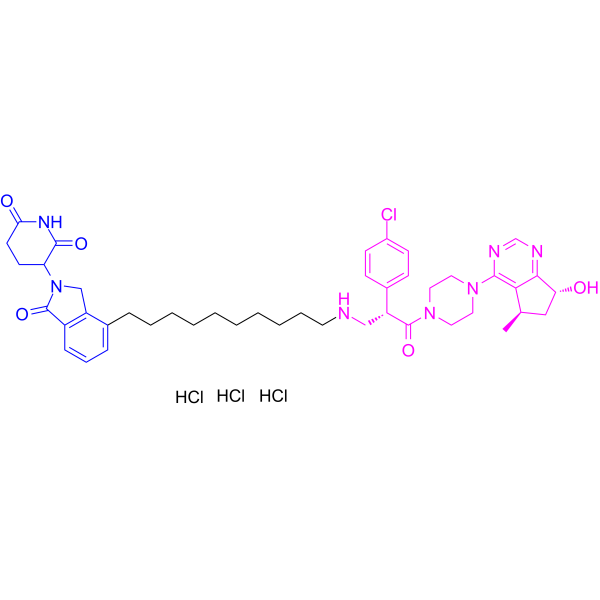
- HY-W760183
-
|
|
Others
|
Cancer
|
|
EM12-SO2F is a powerful covalent inhibitor of CRBN through binding at His353. EM12-SO2F is a useful chemical probe to investigate the CRBN. EM12-SO2F inhibits the degradation of IKZF1 by lenalidomide (HY-A0003) in MOLT4 cells
|
-
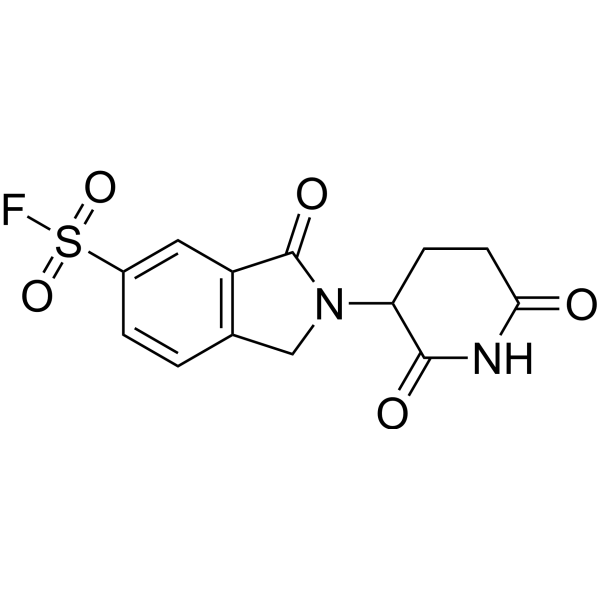
- HY-129602
-
SD-36
5 Publications Verification
|
PROTACs
STAT
Apoptosis
|
Cancer
|
|
SD-36 is a potent and efficacious STAT3 PROTAC degrader (Kd=~50 nM), and demonstrates high selectivity over other STAT members. SD-36 also effectively degrades mutated STAT3 proteins in cells and suppresses the transcriptional activity of STAT3 (IC50=10 nM). SD-36 exerts robust anti-tumor activity, and achieves complete and long-lasting tumor regression in mouse tumor models. SD-36 is composed of the STAT3 inhibitor SI-109, a linker, and an analog of Cereblon ligand Lenalidomide for E3 ubiquitin ligase . SD-36 is a click chemistry reagent, it contains an Alkyne group and can undergo copper-catalyzed azide-alkyne cycloaddition (CuAAc) with molecules containing Azide groups.
|
-
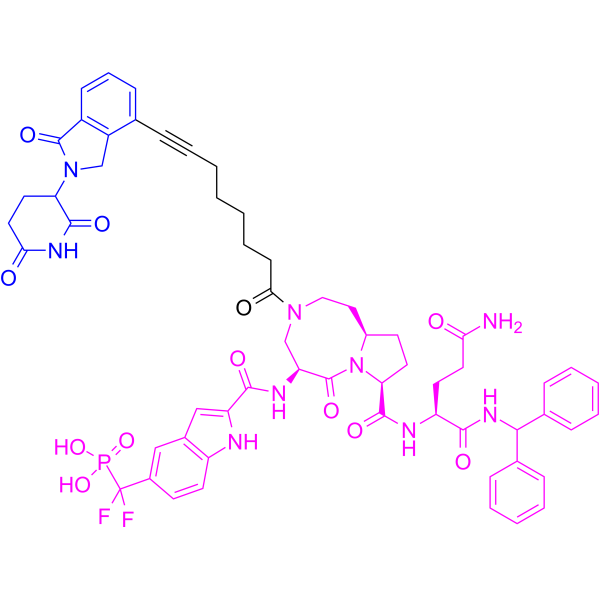
| Cat. No. |
Product Name |
Chemical Structure |
-
- HY-A0003S
-
|
|
|
Lenalidomide-d5 is deuterium labeled Lenalidomide. Lenalidomide (CC-5013), a derivative of Thalidomide, acts as molecular glue. Lenalidomide is an orally active immunomodulator. Lenalidomide (CC-5013) is a ligand of ubiquitin E3 ligase cereblon (CRBN), and it causes selective ubiquitination and degradation of two lymphoid transcription factors, IKZF1 and IKZF3, by the CRBN-CRL4 ubiquitin ligase. Lenalidomide (CC-5013) specifically inhibits growth of mature B-cell lymphomas, including multiple myeloma, and induces IL-2 release from T cells[1][2].
|
-

| Cat. No. |
Product Name |
|
Classification |
-
- HY-133139
-
|
|
|
Azide
|
|
Lenalidomide-PEG1-azide is a E3 ligase lgand-linker conjugate. Lenalidomide-PEG1-azide incorporates the Lenalidomide based cereblon ligand and a linker.?Lenalidomide-PEG1-azide?can be used to design a PROTAC BRD4 Degrader-2 (HY-133136) . Lenalidomide-PEG1-azide is a click chemistry reagent, it contains an Azide group and can undergo copper-catalyzed azide-alkyne cycloaddition reaction (CuAAc) with molecules containing Alkyne groups. Strain-promoted alkyne-azide cycloaddition (SPAAC) can also occur with molecules containing DBCO or BCN groups.
|
-
- HY-161133
-
|
|
|
Azide
|
|
Lenalidomide 4'-PEG1-azide (Compound 4g) is a lenalidomide-derived azide. Lenalidomide 4'-PEG1-azide incorporates the Lenalidomide based cereblon ligand and a linker. Lenalidomide 4'-PEG1-azide is a click chemistry reagent, it contains an Azide group and can undergo copper-catalyzed azide-alkyne cycloaddition reaction (CuAAc) with molecules containing Alkyne groups. Strain-promoted alkyne-azide cycloaddition (SPAAC) can also occur with molecules containing DBCO or BCN groups. .
|
-
- HY-161134
-
|
|
|
Azide
|
|
Lenalidomide 4'-PEG2-azide is the Lenalidomide-based Cereblon ligand used in the recruitment of CRBN protein. Lenalidomide 4'-PEG2-azide can be connected to the ligand for protein by a linker to form PROTAC .
|
-
- HY-161131
-
|
|
|
Azide
|
|
Lenalidomide 4'-alkyl-C3-azide (compound 4a) is a click chemical modified Lenalidomide (HY-A0003) that can be used to synthesize PROTACs. Lenalidomide is an orally active immunomodulator and a ligand for the ubiquitin E3 ligase cereblon (CRBN). Lenalidomide 4'-alkyl-C3-azide contains an Azide group and can undergo copper-catalyzed azide-alkyne cycloaddition reaction (CuAAc) with molecules containing Alkyne groups. Strain-promoted alkyne-azide cycloaddition reactions (SPAAC) can also occur with molecules containing DBCO or BCN groups .
|
-
- HY-161132
-
|
|
|
Azide
|
|
Lenalidomide 4'-alkyl-C5-azide is a functionalized cerebellar ligand for PROTAC development that contains an E3 ligand and an alkyl LC5 ligand with terminal azides that can be coupled to a target protein ligand .
|
-
- HY-130985
-
|
|
|
Alkynes
PROTAC Synthesis
|
|
9-Decyn-1-ol is an alkyl/ether-based PROTAC linker that can be used in the synthesis of PROTACs. 9-Decyn-1-ol can be used to conjugate GDC-0068 with Lenalidomide to generate INY-03-041. INY-03-041 is a potent, highly selective and PROTAC-based pan-Akt degrader. INY-03-041 inhibits Akt1, Akt2 and Akt3 with IC50s of 2.0 nM, 6.8 nM and 3.5 nM, respectively . 9-Decyn-1-ol is a click chemistry reagent, it contains an Alkyne group and can undergo copper-catalyzed azide-alkyne cycloaddition (CuAAc) with molecules containing Azide groups.
|
Your information is safe with us. * Required Fields.
Inquiry Information
- Product Name:
- Cat. No.:
- Quantity:
- MCE Japan Authorized Agent:




























































